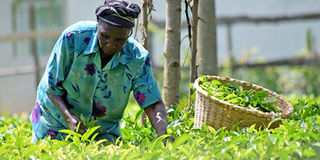Let’s do everything possible to safeguard tea industry

A woman picks tea in a farm in Vokoli, Vihiga County in this past photo. As a country, we need to do what must be done to safeguard the future of the tea industry. PHOTO | FILE | NATION MEDIA GROUP
What you need to know:
- Tea is grown in 21 counties and exported through the Mombasa port.
- Many of the resulting recommendations have been implemented, although with varying results.
- Time has now come for us to delve deeper into the nebulous and persistent problems in the tea subsector.
- Furthermore, such evidence can serve as a benchmark to test future conduct and performance outcomes.
Since the liberalisation of the tea industry in 2000, a lot of changes have taken place in the sector locally and globally.
Globally, there have been new entrants in the market, such as Argentina and Vietnam, while locally, the liberalisation has led to increased production due to rapid expansion in tea planting.
Tea is grown in 21 counties and exported through the Mombasa port. The industry supports more than 600,000 small-scale farmers while more than five million Kenyans are employed directly or indirectly.
For a long time, farmers have complained about increased cost of production due to high labour and fertiliser costs.
Decreasing farmer incomes have raised a lot of public concern, particularly following the unusually low bonus earnings last year.
However, this challenge is not unique to the country. Kenya’s main competitors in the world market, Sri Lanka and India, have taken measures to address the challenges through value addition and product differentiation unlike Kenya, which continues to sell its tea in bulk.
In the past 20 years, the government and Kenya Tea Development Agency (KTDA) have conducted many investigations into the various policy, management and regulatory problems in the industry, including through the tea task forces in 2007 and 2016.
Many of the resulting recommendations have been implemented, although with varying results. Time has now come for us to delve deeper into the nebulous and persistent problems in the tea subsector.
Since President Daniel arap Moi’s era to Uhuru Kenyatta’s, Cabinet ministers have seldom lasted long enough to successfully implement subsector specific policy interventions. Often, they have left without crafting and implementing any meaningful policy.
SOLVE MARKET FAILURES
In some cases, experienced career civil servants that have attempted to moderate policy proposals, with evidence, have been deemed to be obstructive and replaced with political special policy advisers, some with limited technical knowledge.
Good economic policies that not only solve market failures but also unleash beneficial political forces should be supported.
There are persistent claims of cartels in the tea industry, especially at the marketing (transportation, insurance and brokerage) segments of the value chain.
It is perhaps important to note that some of the structural foundations of these cartels started when tea was under the greater control of the government as KTDA, until 2000 when it was transformed into an agency.
It seems the said cartels got way of how to arm-twist the agency. Ways must be found to reduce the economic rents for such cartels and pass the hidden gains to farmers.
There is need for empirical and objective evidence to assist in making correct policy, regulatory and institutional prescriptions.
Such evidence could help to contextualise persistent structural, conduct and performance problems in the tea industry in a manner that can succinctly capture the attention of policy and decision-makers and lay to rest lies and innuendoes.
Furthermore, such evidence can serve as a benchmark to test future conduct and performance outcomes.
Reactions to short-term events can throw off course the development of policies intended to have long-term impacts such as sustainability of tea as an economic sector, employment and foreign exchange earnings.
SAFEGUARD FUTURE OF TEA INDUSTRY
Some of the emerging issues include addressing the raising wages of farm workers (such as plucking) versus mechanisation.
There has been considerable resistance towards introduction of tea plucking machines for small-scale factories largely meant to guarantee employment for pickers.
It is common knowledge that tea pickers demand higher payment (per kilogramme of green leaf). Suppose farmers pool resources and adopt tea plucking machines, what are the alternative sources of employment for current tea pickers?
Second, policy and institutional focus on marketing and trade practices should be given attention and tea production challenges such as extension and advisory services dealt with to enable farmers run tea farming as a business.
Third, as a country, little evidence exists that we have been vigorously and deliberately exploring alternative business growth opportunities like new high-income export markets.
Such evidence should also be open to rigorous public and professional debate. As well as validating evidence, transparency can help governments to gauge community reaction to ideas before they are fully formed.
Everyone knows what privatisation of the agricultural sector has caused in other sectors like sugar. Indeed, privatisation has fostered depoliticisation but mechanism must be put in place to ensure that the process does not enrich and empower unscrupulous firms or individuals.
As a country, we need to do what must be done to safeguard the future of the tea industry.
Dr Omiti is an economist and policy consultant; [email protected].





